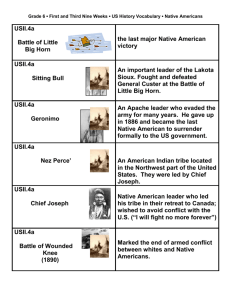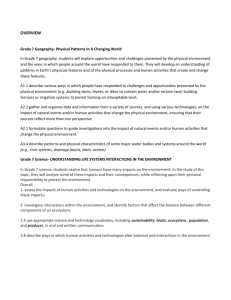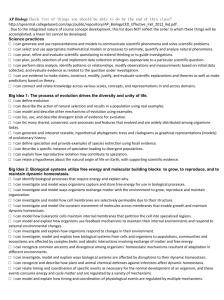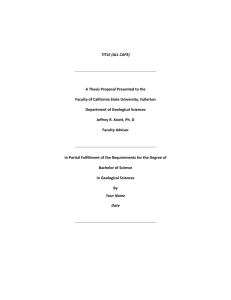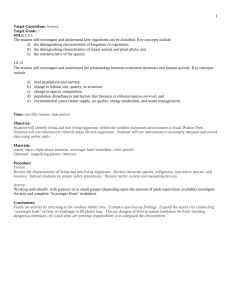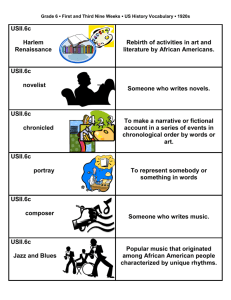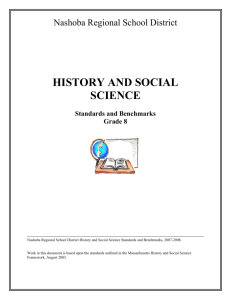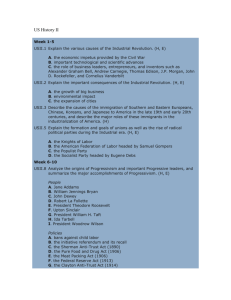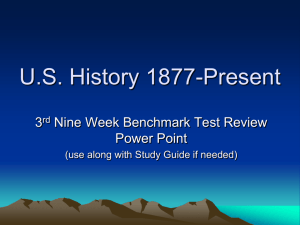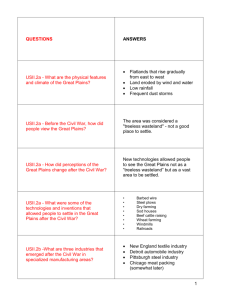WHAT YOUR CHILD WILL LEARN THIS YEAR IN SEVENTH
advertisement
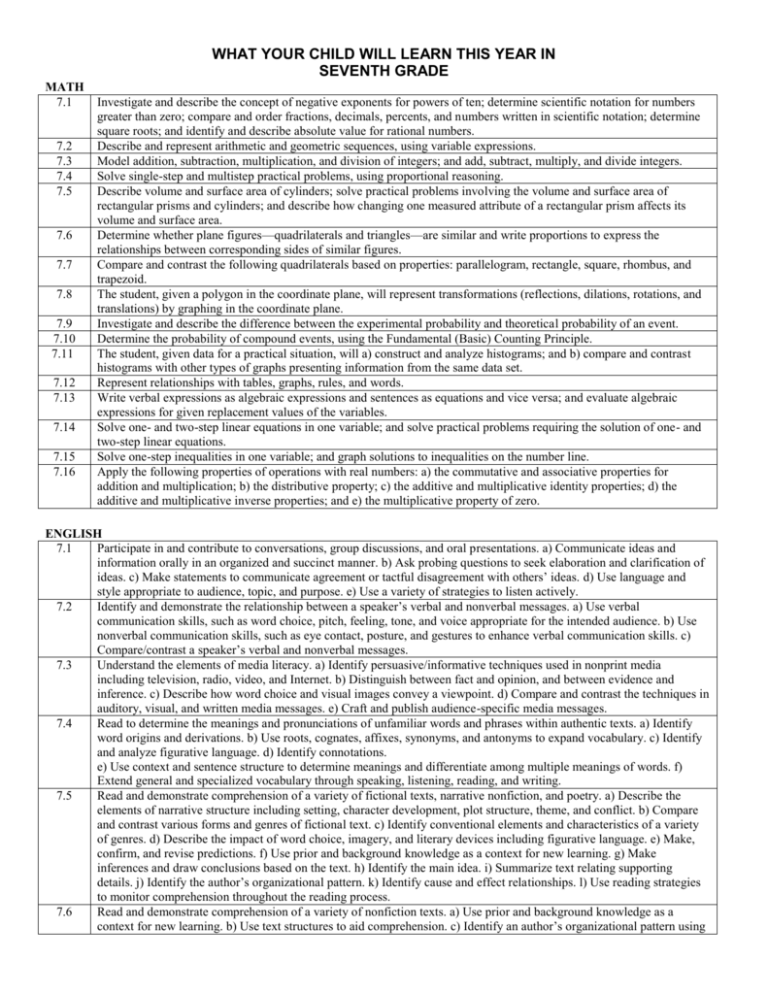
WHAT YOUR CHILD WILL LEARN THIS YEAR IN SEVENTH GRADE MATH 7.1 7.2 7.3 7.4 7.5 7.6 7.7 7.8 7.9 7.10 7.11 7.12 7.13 7.14 7.15 7.16 Investigate and describe the concept of negative exponents for powers of ten; determine scientific notation for numbers greater than zero; compare and order fractions, decimals, percents, and numbers written in scientific notation; determine square roots; and identify and describe absolute value for rational numbers. Describe and represent arithmetic and geometric sequences, using variable expressions. Model addition, subtraction, multiplication, and division of integers; and add, subtract, multiply, and divide integers. Solve single-step and multistep practical problems, using proportional reasoning. Describe volume and surface area of cylinders; solve practical problems involving the volume and surface area of rectangular prisms and cylinders; and describe how changing one measured attribute of a rectangular prism affects its volume and surface area. Determine whether plane figures—quadrilaterals and triangles—are similar and write proportions to express the relationships between corresponding sides of similar figures. Compare and contrast the following quadrilaterals based on properties: parallelogram, rectangle, square, rhombus, and trapezoid. The student, given a polygon in the coordinate plane, will represent transformations (reflections, dilations, rotations, and translations) by graphing in the coordinate plane. Investigate and describe the difference between the experimental probability and theoretical probability of an event. Determine the probability of compound events, using the Fundamental (Basic) Counting Principle. The student, given data for a practical situation, will a) construct and analyze histograms; and b) compare and contrast histograms with other types of graphs presenting information from the same data set. Represent relationships with tables, graphs, rules, and words. Write verbal expressions as algebraic expressions and sentences as equations and vice versa; and evaluate algebraic expressions for given replacement values of the variables. Solve one- and two-step linear equations in one variable; and solve practical problems requiring the solution of one- and two-step linear equations. Solve one-step inequalities in one variable; and graph solutions to inequalities on the number line. Apply the following properties of operations with real numbers: a) the commutative and associative properties for addition and multiplication; b) the distributive property; c) the additive and multiplicative identity properties; d) the additive and multiplicative inverse properties; and e) the multiplicative property of zero. ENGLISH 7.1 Participate in and contribute to conversations, group discussions, and oral presentations. a) Communicate ideas and information orally in an organized and succinct manner. b) Ask probing questions to seek elaboration and clarification of ideas. c) Make statements to communicate agreement or tactful disagreement with others’ ideas. d) Use language and style appropriate to audience, topic, and purpose. e) Use a variety of strategies to listen actively. 7.2 Identify and demonstrate the relationship between a speaker’s verbal and nonverbal messages. a) Use verbal communication skills, such as word choice, pitch, feeling, tone, and voice appropriate for the intended audience. b) Use nonverbal communication skills, such as eye contact, posture, and gestures to enhance verbal communication skills. c) Compare/contrast a speaker’s verbal and nonverbal messages. 7.3 Understand the elements of media literacy. a) Identify persuasive/informative techniques used in nonprint media including television, radio, video, and Internet. b) Distinguish between fact and opinion, and between evidence and inference. c) Describe how word choice and visual images convey a viewpoint. d) Compare and contrast the techniques in auditory, visual, and written media messages. e) Craft and publish audience-specific media messages. 7.4 Read to determine the meanings and pronunciations of unfamiliar words and phrases within authentic texts. a) Identify word origins and derivations. b) Use roots, cognates, affixes, synonyms, and antonyms to expand vocabulary. c) Identify and analyze figurative language. d) Identify connotations. e) Use context and sentence structure to determine meanings and differentiate among multiple meanings of words. f) Extend general and specialized vocabulary through speaking, listening, reading, and writing. 7.5 Read and demonstrate comprehension of a variety of fictional texts, narrative nonfiction, and poetry. a) Describe the elements of narrative structure including setting, character development, plot structure, theme, and conflict. b) Compare and contrast various forms and genres of fictional text. c) Identify conventional elements and characteristics of a variety of genres. d) Describe the impact of word choice, imagery, and literary devices including figurative language. e) Make, confirm, and revise predictions. f) Use prior and background knowledge as a context for new learning. g) Make inferences and draw conclusions based on the text. h) Identify the main idea. i) Summarize text relating supporting details. j) Identify the author’s organizational pattern. k) Identify cause and effect relationships. l) Use reading strategies to monitor comprehension throughout the reading process. 7.6 Read and demonstrate comprehension of a variety of nonfiction texts. a) Use prior and background knowledge as a context for new learning. b) Use text structures to aid comprehension. c) Identify an author’s organizational pattern using 7.7 7.8 7.9 textual clues, such as transitional words and phrases. d) Draw conclusions and make inferences on explicit and implied information. e) Differentiate between fact and opinion. f) Identify the source, viewpoint, and purpose of texts. g) Describe how word choice and language structure convey an author’s viewpoint. h) Identify the main idea. i) Summarize text identifying supporting details. j) Identify cause and effect relationships. k) Organize and synthesize information for use in written formats. l) Use reading strategies to monitor comprehension throughout the reading process. Write in a variety of forms with an emphasis on exposition, narration, and persuasion. a) Identify intended audience. b) Use a variety of prewriting strategies including graphic organizers to generate and organize ideas. c) Organize writing structure to fit mode or topic. d) Establish a central idea and organization. e) Compose a topic sentence or thesis statement. f) Write multiparagraph compositions with unity elaborating the central idea. g) Select vocabulary and information to enhance the central idea, tone, and voice. h) Expand and embed ideas by using modifiers, standard coordination, and subordination in complete sentences. i) Use clauses and phrases for sentence variety. j) Revise sentences for clarity of content including specific vocabulary and information. k) Use computer technology to plan, draft, revise, edit, and publish writing. Edit writing for correct grammar, capitalization, punctuation, spelling, sentence structure, and paragraphing. a) Use a variety of graphic organizers, including sentence diagrams, to analyze and improve sentence formation and paragraph structure. b) Choose appropriate adjectives and adverbs to enhance writing. c) Use pronoun-antecedent agreement to include indefinite pronouns. d) Use subject-verb agreement with intervening phrases and clauses. e) Edit for verb tense consistency and point of view. f) Demonstrate understanding of sentence formation by identifying the eight parts of speech and their functions in sentences. g) Use quotation marks with dialogue. h) Use correct spelling for commonly used words. Apply knowledge of appropriate reference materials to produce a research product. a) Collect and organize information from multiple sources including online, print and media. b) Evaluate the validity and authenticity of sources. c) Use technology as a tool to research, organize, evaluate, and communicate information. d) Cite primary and secondary sources. e) Define the meaning and consequences of plagiarism and follow ethical and legal guidelines for gathering and using information. SCIENCE LS.1 Demonstrate an understanding of scientific reasoning, logic, and the nature of science by planning and conducting investigations in which a) data are organized into tables showing repeated trials and means; b) a classification system is developed based on multiple attributes; c) triple beam and electronic balances, thermometers, metric rulers, graduated cylinders, and probeware are used to gather data; d) models and simulations are constructed and used to illustrate and explain phenomena; e) sources of experimental error are identified; f) dependent variables, independent variables, and constants are identified; g) variables are controlled to test hypotheses, and trials are repeated; h) data are organized, communicated through graphical representation, interpreted, and used to make predictions; i) patterns are identified in data and are interpreted and evaluated; and j) current applications are used to reinforce life science concepts. LS.2 Investigate and understand that all living things are composed of cells. Key concepts include a) cell structure and organelles; b) similarities and differences between plant and animal cells; c) development of cell theory; and d) cell division. LS.3 Investigate and understand that living things show patterns of cellular organization. Key concepts include a) cells, tissues, organs, and systems; and b) patterns of cellular organization and their relationship to life processes in living things. LS.4 Investigate and understand how organisms can be classified. Key concepts include a) the distinguishing characteristics of domains of organisms; b) the distinguishing characteristics of kingdoms of organisms; c) the distinguishing characteristics of major animal phyla and plant divisions; and d) the characteristics that define a species. LS.5 Investigate and understand the basic physical and chemical processes of photosynthesis and its importance to plant and animal life. Key concepts include a) energy transfer between sunlight and chlorophyll; b) transformation of water and carbon dioxide into sugar and oxygen; and c) photosynthesis as the foundation of virtually all food webs. LS.6 Investigate and understand that organisms within an ecosystem are dependent on one another and on nonliving components of the environment. Key concepts include a) the carbon, water, and nitrogen cycles; b) interactions resulting in a flow of energy and matter throughout the system; c) complex relationships within terrestrial, freshwater, and marine ecosystems; and d) energy flow in food webs and energy pyramids. LS.7 Investigate and understand that interactions exist among members of a population. Key concepts include a) competition, cooperation, social hierarchy, territorial imperative; and b) influence of behavior on a population. LS.8 Investigate and understand interactions among populations in a biological community. Key concepts include a) the relationships among producers, consumers, and decomposers in food webs; b) the relationship between predators and prey; c) competition and cooperation; d) symbiotic relationships; and e) niches. LS.9 Investigate and understand how organisms adapt to biotic and abiotic factors in an ecosystem. Key concepts include a) differences between ecosystems and biomes; b) characteristics of land, marine, and freshwater ecosystems; and c) adaptations that enable organisms to survive within a specific ecosystem. LS.10 Investigate and understand that ecosystems, communities, populations, and organisms are dynamic, change over time, and respond to daily, seasonal, and long-term changes in their environment. Key concepts include a) phototropism, hibernation, and dormancy; b) factors that increase or decrease population size; and c) eutrophication, climate changes, LS.11 LS.12 LS.13 and catastrophic disturbances. Investigate and understand the relationships between ecosystem dynamics and human activity. Key concepts include a) food production and harvest; b) change in habitat size, quality, or structure; c) change in species competition; d) population disturbances and factors that threaten or enhance species survival; and e) environmental issues. Investigate and understand that organisms reproduce and transmit genetic information to new generations. Key concepts include a) the structure and role of DNA; b) the function of genes and chromosomes; c) genotypes and phenotypes; d) characteristics that can and cannot be inherited; e) genetic engineering and its applications; and f) historical contributions and significance of discoveries related to genetics. Investigate and understand that populations of organisms change over time. Key concepts include a) the relationships of mutation, adaptation, natural selection, and extinction; b) evidence of evolution of different species in the fossil record; and c) how environmental influences, as well as genetic variation, can lead to diversity of organisms. HISTORY USII.1 Demonstrate skills for historical and geographical analysis and responsible citizenship, including the ability to a) analyze and interpret primary and secondary source documents to increase understanding of events and life in United States history from 1865 to the present; b) make connections between the past and the present; c) sequence events in United States history from 1865 to the present; d) interpret ideas and events from different historical perspectives; e) evaluate and debate issues orally and in writing; f) analyze and interpret maps that include major physical features; g) use parallels of latitude and meridians of longitude to describe hemispheric location; h) interpret patriotic slogans and excerpts from notable speeches and documents; i) identify the costs and benefits of specific choices made, including the consequences, both intended and unintended, of the decisions and how people and nations responded to positive and negative incentives. USII.2 Use maps, globes, photographs, pictures, or tables for a) explaining how physical features and climate influenced the movement of people westward; b) explaining relationships among natural resources, transportation, and industrial development after 1865; c) locating the 50 states and the cities most significant to the historical development of the United States. USII.3 Demonstrate knowledge of the effects of Reconstruction on American life by a) analyzing the impact of the 13th, 14th, and 15th Amendments to the Constitution of the United States; b) describing the impact of Reconstruction policies on the South and North; c) describing the legacies of Abraham Lincoln, Robert E. Lee, and Frederick Douglass. USII.4 Demonstrate knowledge of how life changed after the Civil War by a) identifying the reasons for westward expansion, including its impact on American Indians; b) explaining the reasons for the increase in immigration, growth of cities, new inventions, and challenges arising from this expansion; c) describing racial segregation, the rise of “Jim Crow,” and other constraints faced by African Americans and other groups in the post-Reconstruction South; d) explaining the impact of new inventions, the rise of big business, the growth of industry, and life on American farms; e) describing the impact of the Progressive Movement on child labor, working conditions, the rise of organized labor, women’s suffrage, and the temperance movement. USII.5 Demonstrate knowledge of the changing role of the United States from the late nineteenth century through World War I by a) explaining the reasons for and results of the Spanish American War; b) describing Theodore Roosevelt’s impact on the foreign policy of the United States; c) explaining the reasons for the United States’ involvement in World War I and its international leadership role at the conclusion of the war. USII.6 Demonstrate knowledge of the social, economic, and technological changes of the early twentieth century by a) explaining how developments in factory and labor productivity, transportation (including the use of the automobile), communication, and rural electrification changed American life and standard of living; b) describing the social and economic changes that took place, including prohibition and the Great Migration north and west; c) examining art, literature, and music from the 1920s and 1930s, with emphasis on Langston Hughes, Duke Ellington, Georgia O’Keeffe, and the Harlem Renaissance; d) identifying the causes of the Great Depression, its impact on Americans, and the major features of Franklin D. Roosevelt’s New Deal. USII.7 Demonstrate knowledge of the major causes and effects of American involvement in World War II by a) identifying the causes and events that led to American involvement in the war, including the attack on Pearl Harbor; b) locating and describing the major events and turning points of the war in Europe and the Pacific; c) describing the impact of the war on the home front. USII.8 Demonstrate knowledge of the economic, social, and political transformation of the United States and the world between the end of World War II and the present by a) describing the rebuilding of Europe and Japan after World War II, the emergence of the United States as a superpower, and the establishment of the United Nations; b) describing the conversion from a wartime to a peacetime economy; c) identifying the role of America’s military and veterans in defending freedom during the Cold War, including the wars in Korea and Vietnam, the Cuban missile crisis, the collapse of communism in Europe, and the rise of new challenges; d) describing the changing patterns of society, including expanded educational and economic opportunities for military veterans, women, and minorities; e) describing how international trade and globalization have impacted American life. USII.9 Demonstrate knowledge of the key domestic and international issues during the second half of the twentieth and early twentyfirst centuries by a) examining the Civil Rights Movement and the changing role of women; b) describing the development of new technologies in communication, entertainment, and business and their impact on American life; c) identifying representative citizens from the time period who have influenced America scientifically, culturally, academically, and economically; d) examining American foreign policy, immigration, the global environment, and other emerging issues.

